Evidence Appraisal Report: Effects of Garcinia Cambogia on Obesity
VerifiedAdded on 2020/02/24
|8
|1926
|129
Report
AI Summary
This report presents an evidence appraisal of a study investigating the effects of Garcinia cambogia extract on weight management and metabolic factors in obese women. The study employed a double-blind, randomized design, involving 60 participants. The researchers aimed to determine if Garcinia cambogia treatment affected weight, anthropometric measurements, lipid profiles, and leptin levels. The study's methodology included assessing dietary intake, body composition, and resting energy expenditure. The findings indicated that Garcinia cambogia treatment did not significantly impact anthropometric or metabolic parameters, contradicting some previous studies. The report analyzes the study's internal and external validity, discussing potential threats and limitations, such as the impact of HCA and the exclusion of family history of obesity, and offers suggestions for improvement. The study concludes that Garcinia cambogia treatment for obese people is not worthy of trying.
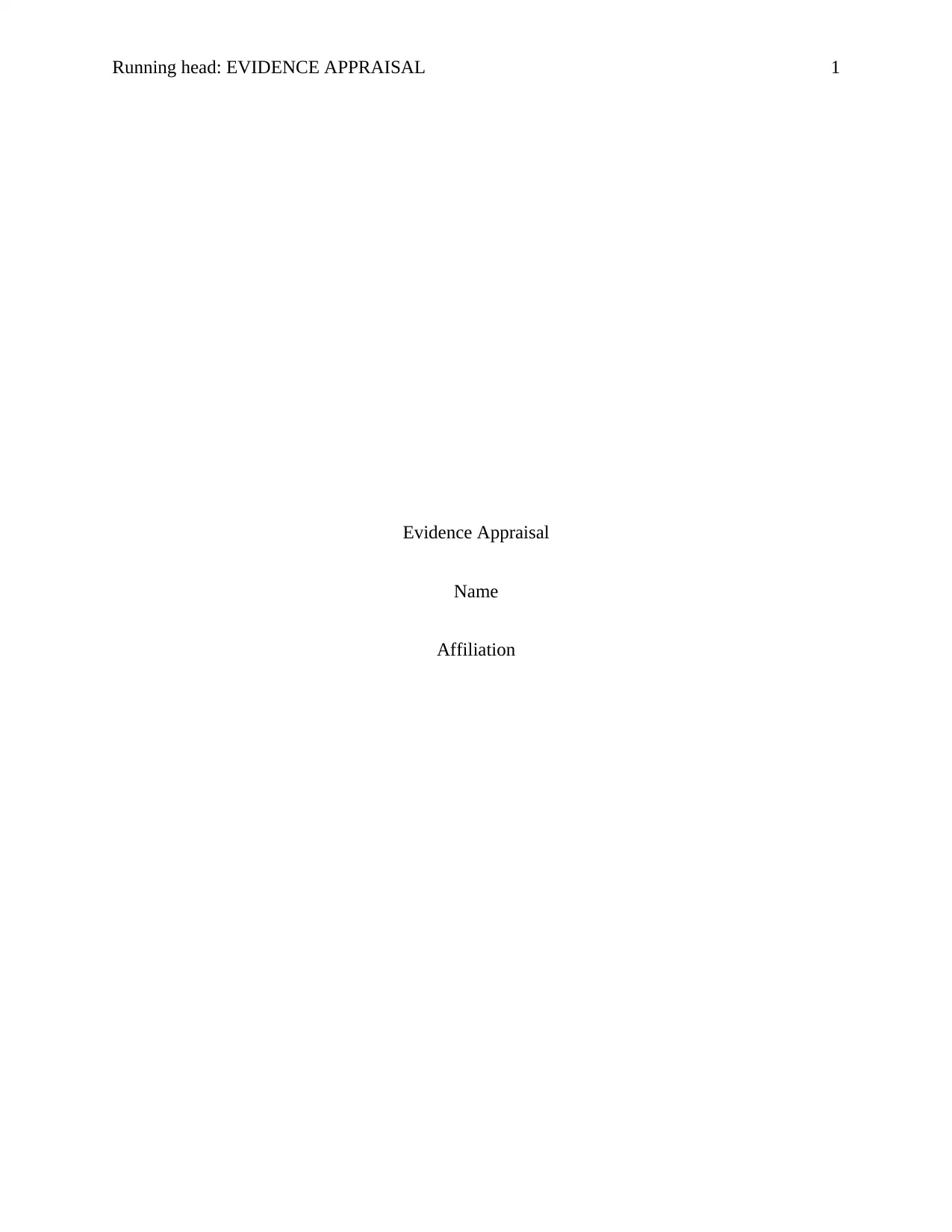
Running head: EVIDENCE APPRAISAL 1
Evidence Appraisal
Name
Affiliation
Evidence Appraisal
Name
Affiliation
Paraphrase This Document
Need a fresh take? Get an instant paraphrase of this document with our AI Paraphraser
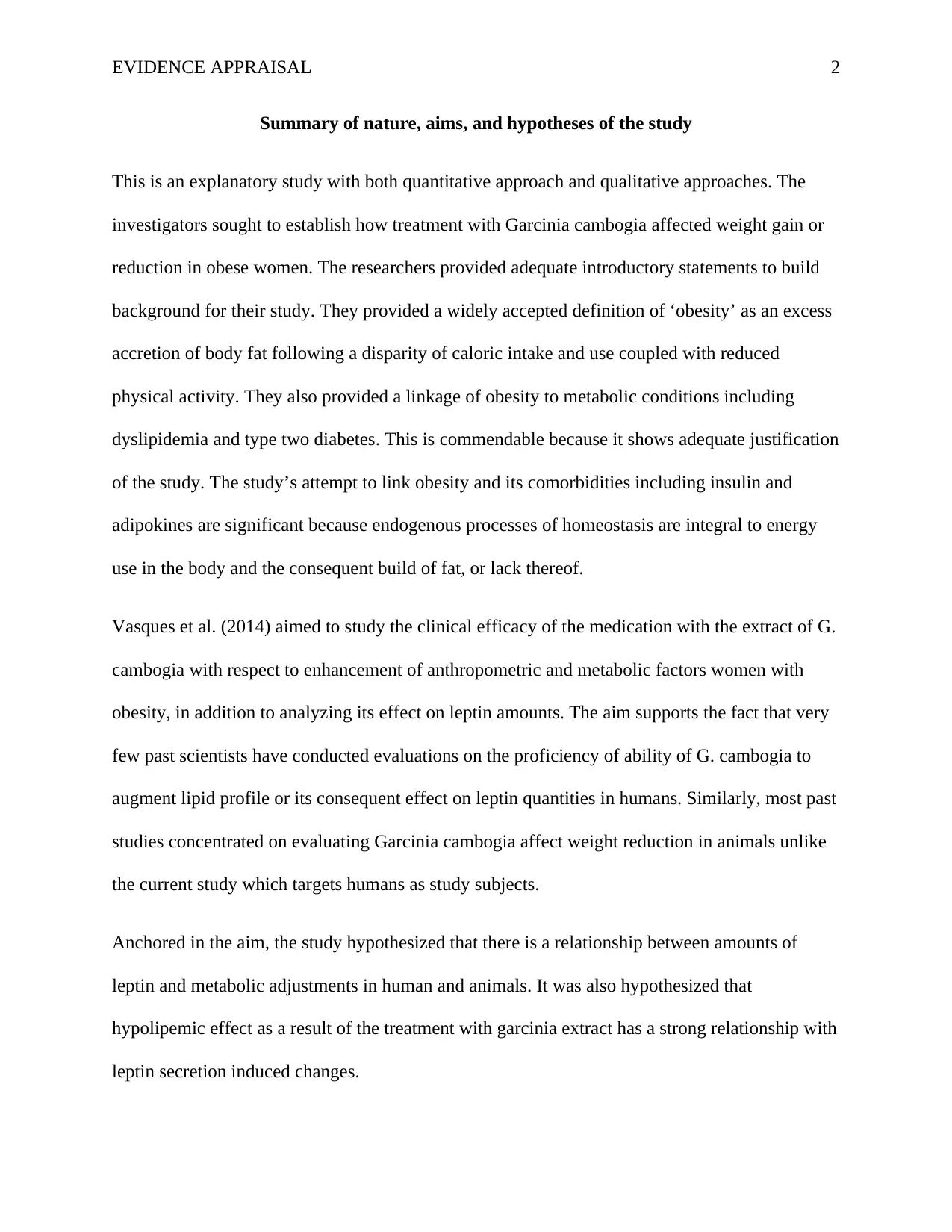
EVIDENCE APPRAISAL 2
Summary of nature, aims, and hypotheses of the study
This is an explanatory study with both quantitative approach and qualitative approaches. The
investigators sought to establish how treatment with Garcinia cambogia affected weight gain or
reduction in obese women. The researchers provided adequate introductory statements to build
background for their study. They provided a widely accepted definition of ‘obesity’ as an excess
accretion of body fat following a disparity of caloric intake and use coupled with reduced
physical activity. They also provided a linkage of obesity to metabolic conditions including
dyslipidemia and type two diabetes. This is commendable because it shows adequate justification
of the study. The study’s attempt to link obesity and its comorbidities including insulin and
adipokines are significant because endogenous processes of homeostasis are integral to energy
use in the body and the consequent build of fat, or lack thereof.
Vasques et al. (2014) aimed to study the clinical efficacy of the medication with the extract of G.
cambogia with respect to enhancement of anthropometric and metabolic factors women with
obesity, in addition to analyzing its effect on leptin amounts. The aim supports the fact that very
few past scientists have conducted evaluations on the proficiency of ability of G. cambogia to
augment lipid profile or its consequent effect on leptin quantities in humans. Similarly, most past
studies concentrated on evaluating Garcinia cambogia affect weight reduction in animals unlike
the current study which targets humans as study subjects.
Anchored in the aim, the study hypothesized that there is a relationship between amounts of
leptin and metabolic adjustments in human and animals. It was also hypothesized that
hypolipemic effect as a result of the treatment with garcinia extract has a strong relationship with
leptin secretion induced changes.
Summary of nature, aims, and hypotheses of the study
This is an explanatory study with both quantitative approach and qualitative approaches. The
investigators sought to establish how treatment with Garcinia cambogia affected weight gain or
reduction in obese women. The researchers provided adequate introductory statements to build
background for their study. They provided a widely accepted definition of ‘obesity’ as an excess
accretion of body fat following a disparity of caloric intake and use coupled with reduced
physical activity. They also provided a linkage of obesity to metabolic conditions including
dyslipidemia and type two diabetes. This is commendable because it shows adequate justification
of the study. The study’s attempt to link obesity and its comorbidities including insulin and
adipokines are significant because endogenous processes of homeostasis are integral to energy
use in the body and the consequent build of fat, or lack thereof.
Vasques et al. (2014) aimed to study the clinical efficacy of the medication with the extract of G.
cambogia with respect to enhancement of anthropometric and metabolic factors women with
obesity, in addition to analyzing its effect on leptin amounts. The aim supports the fact that very
few past scientists have conducted evaluations on the proficiency of ability of G. cambogia to
augment lipid profile or its consequent effect on leptin quantities in humans. Similarly, most past
studies concentrated on evaluating Garcinia cambogia affect weight reduction in animals unlike
the current study which targets humans as study subjects.
Anchored in the aim, the study hypothesized that there is a relationship between amounts of
leptin and metabolic adjustments in human and animals. It was also hypothesized that
hypolipemic effect as a result of the treatment with garcinia extract has a strong relationship with
leptin secretion induced changes.
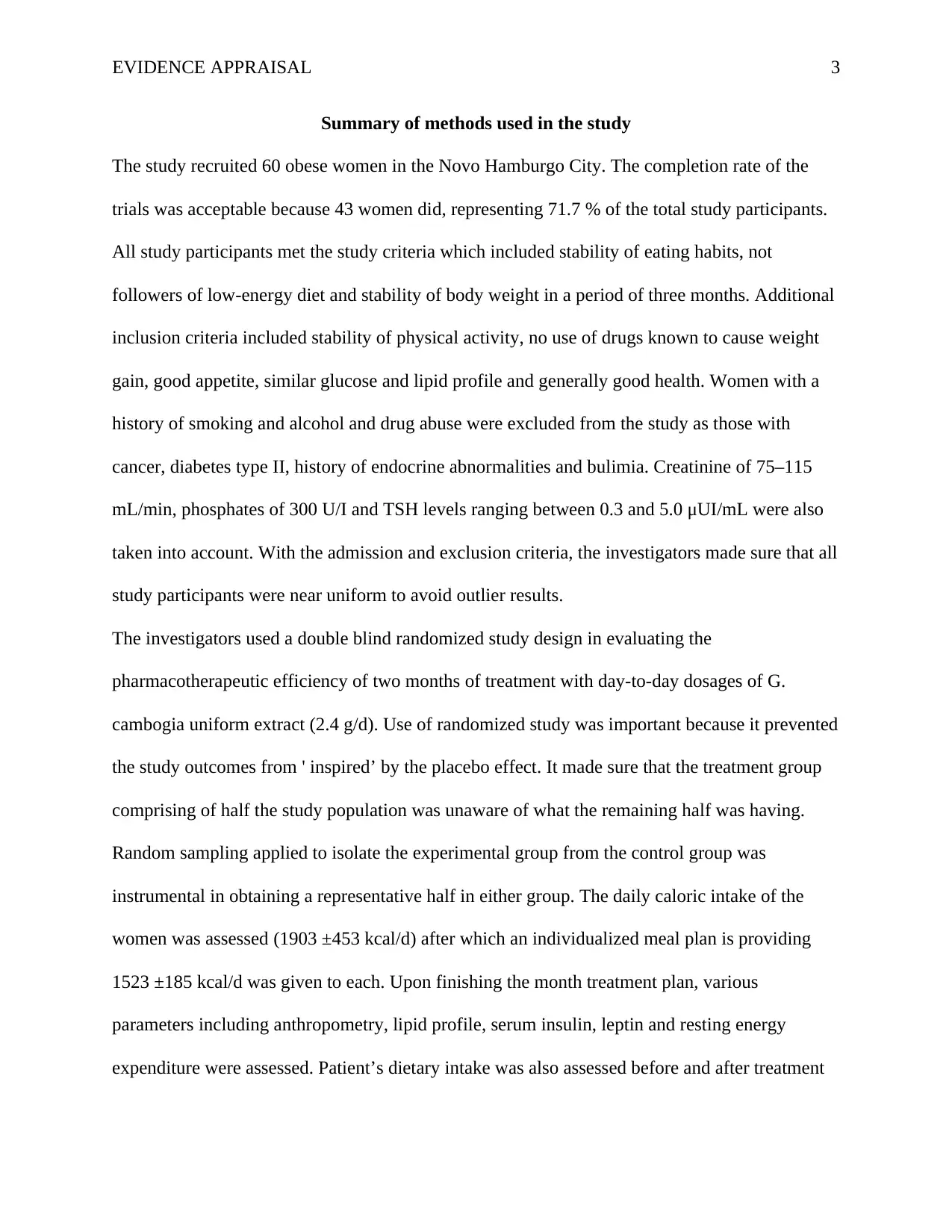
EVIDENCE APPRAISAL 3
Summary of methods used in the study
The study recruited 60 obese women in the Novo Hamburgo City. The completion rate of the
trials was acceptable because 43 women did, representing 71.7 % of the total study participants.
All study participants met the study criteria which included stability of eating habits, not
followers of low-energy diet and stability of body weight in a period of three months. Additional
inclusion criteria included stability of physical activity, no use of drugs known to cause weight
gain, good appetite, similar glucose and lipid profile and generally good health. Women with a
history of smoking and alcohol and drug abuse were excluded from the study as those with
cancer, diabetes type II, history of endocrine abnormalities and bulimia. Creatinine of 75–115
mL/min, phosphates of 300 U/I and TSH levels ranging between 0.3 and 5.0 μUI/mL were also
taken into account. With the admission and exclusion criteria, the investigators made sure that all
study participants were near uniform to avoid outlier results.
The investigators used a double blind randomized study design in evaluating the
pharmacotherapeutic efficiency of two months of treatment with day-to-day dosages of G.
cambogia uniform extract (2.4 g/d). Use of randomized study was important because it prevented
the study outcomes from ' inspired’ by the placebo effect. It made sure that the treatment group
comprising of half the study population was unaware of what the remaining half was having.
Random sampling applied to isolate the experimental group from the control group was
instrumental in obtaining a representative half in either group. The daily caloric intake of the
women was assessed (1903 ±453 kcal/d) after which an individualized meal plan is providing
1523 ±185 kcal/d was given to each. Upon finishing the month treatment plan, various
parameters including anthropometry, lipid profile, serum insulin, leptin and resting energy
expenditure were assessed. Patient’s dietary intake was also assessed before and after treatment
Summary of methods used in the study
The study recruited 60 obese women in the Novo Hamburgo City. The completion rate of the
trials was acceptable because 43 women did, representing 71.7 % of the total study participants.
All study participants met the study criteria which included stability of eating habits, not
followers of low-energy diet and stability of body weight in a period of three months. Additional
inclusion criteria included stability of physical activity, no use of drugs known to cause weight
gain, good appetite, similar glucose and lipid profile and generally good health. Women with a
history of smoking and alcohol and drug abuse were excluded from the study as those with
cancer, diabetes type II, history of endocrine abnormalities and bulimia. Creatinine of 75–115
mL/min, phosphates of 300 U/I and TSH levels ranging between 0.3 and 5.0 μUI/mL were also
taken into account. With the admission and exclusion criteria, the investigators made sure that all
study participants were near uniform to avoid outlier results.
The investigators used a double blind randomized study design in evaluating the
pharmacotherapeutic efficiency of two months of treatment with day-to-day dosages of G.
cambogia uniform extract (2.4 g/d). Use of randomized study was important because it prevented
the study outcomes from ' inspired’ by the placebo effect. It made sure that the treatment group
comprising of half the study population was unaware of what the remaining half was having.
Random sampling applied to isolate the experimental group from the control group was
instrumental in obtaining a representative half in either group. The daily caloric intake of the
women was assessed (1903 ±453 kcal/d) after which an individualized meal plan is providing
1523 ±185 kcal/d was given to each. Upon finishing the month treatment plan, various
parameters including anthropometry, lipid profile, serum insulin, leptin and resting energy
expenditure were assessed. Patient’s dietary intake was also assessed before and after treatment
⊘ This is a preview!⊘
Do you want full access?
Subscribe today to unlock all pages.

Trusted by 1+ million students worldwide
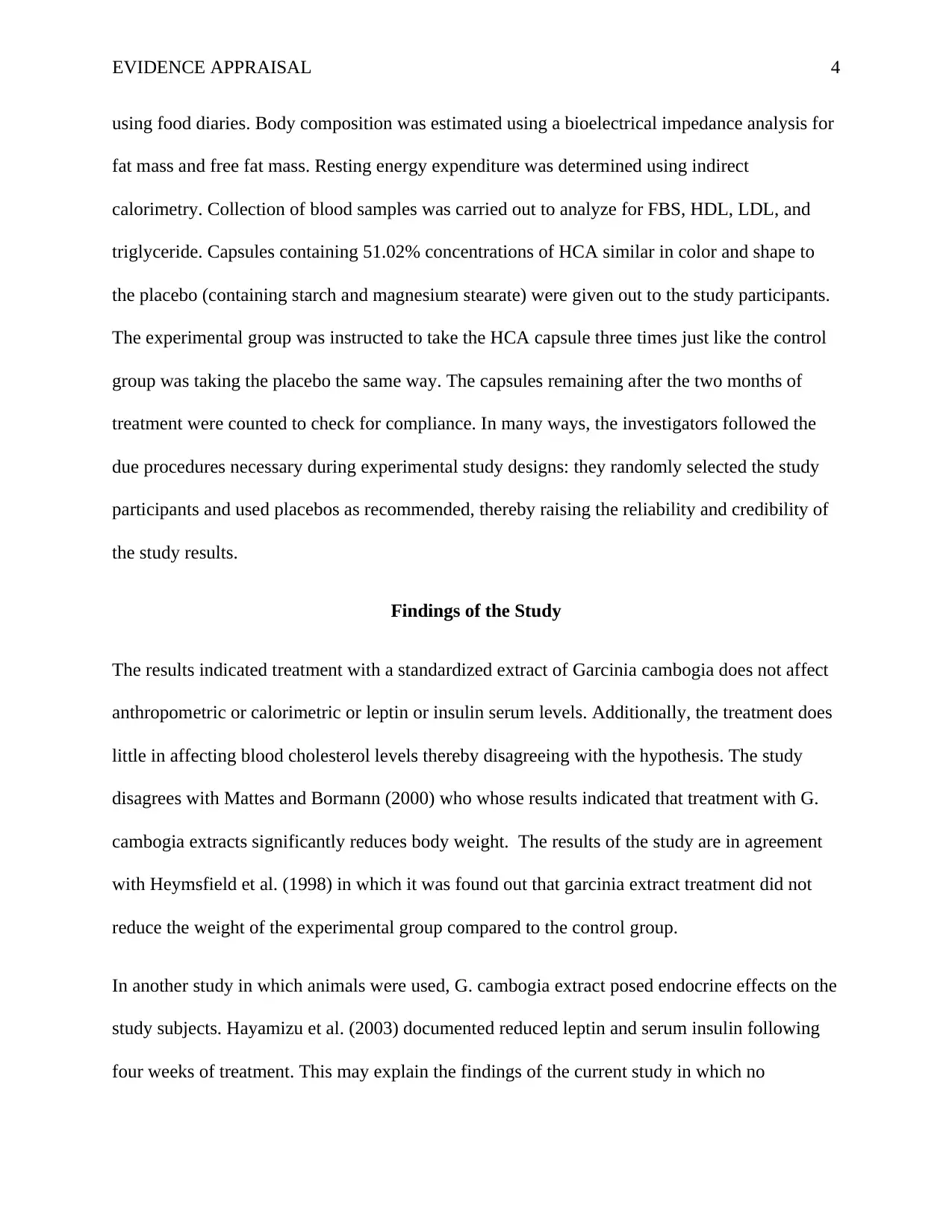
EVIDENCE APPRAISAL 4
using food diaries. Body composition was estimated using a bioelectrical impedance analysis for
fat mass and free fat mass. Resting energy expenditure was determined using indirect
calorimetry. Collection of blood samples was carried out to analyze for FBS, HDL, LDL, and
triglyceride. Capsules containing 51.02% concentrations of HCA similar in color and shape to
the placebo (containing starch and magnesium stearate) were given out to the study participants.
The experimental group was instructed to take the HCA capsule three times just like the control
group was taking the placebo the same way. The capsules remaining after the two months of
treatment were counted to check for compliance. In many ways, the investigators followed the
due procedures necessary during experimental study designs: they randomly selected the study
participants and used placebos as recommended, thereby raising the reliability and credibility of
the study results.
Findings of the Study
The results indicated treatment with a standardized extract of Garcinia cambogia does not affect
anthropometric or calorimetric or leptin or insulin serum levels. Additionally, the treatment does
little in affecting blood cholesterol levels thereby disagreeing with the hypothesis. The study
disagrees with Mattes and Bormann (2000) who whose results indicated that treatment with G.
cambogia extracts significantly reduces body weight. The results of the study are in agreement
with Heymsfield et al. (1998) in which it was found out that garcinia extract treatment did not
reduce the weight of the experimental group compared to the control group.
In another study in which animals were used, G. cambogia extract posed endocrine effects on the
study subjects. Hayamizu et al. (2003) documented reduced leptin and serum insulin following
four weeks of treatment. This may explain the findings of the current study in which no
using food diaries. Body composition was estimated using a bioelectrical impedance analysis for
fat mass and free fat mass. Resting energy expenditure was determined using indirect
calorimetry. Collection of blood samples was carried out to analyze for FBS, HDL, LDL, and
triglyceride. Capsules containing 51.02% concentrations of HCA similar in color and shape to
the placebo (containing starch and magnesium stearate) were given out to the study participants.
The experimental group was instructed to take the HCA capsule three times just like the control
group was taking the placebo the same way. The capsules remaining after the two months of
treatment were counted to check for compliance. In many ways, the investigators followed the
due procedures necessary during experimental study designs: they randomly selected the study
participants and used placebos as recommended, thereby raising the reliability and credibility of
the study results.
Findings of the Study
The results indicated treatment with a standardized extract of Garcinia cambogia does not affect
anthropometric or calorimetric or leptin or insulin serum levels. Additionally, the treatment does
little in affecting blood cholesterol levels thereby disagreeing with the hypothesis. The study
disagrees with Mattes and Bormann (2000) who whose results indicated that treatment with G.
cambogia extracts significantly reduces body weight. The results of the study are in agreement
with Heymsfield et al. (1998) in which it was found out that garcinia extract treatment did not
reduce the weight of the experimental group compared to the control group.
In another study in which animals were used, G. cambogia extract posed endocrine effects on the
study subjects. Hayamizu et al. (2003) documented reduced leptin and serum insulin following
four weeks of treatment. This may explain the findings of the current study in which no
Paraphrase This Document
Need a fresh take? Get an instant paraphrase of this document with our AI Paraphraser
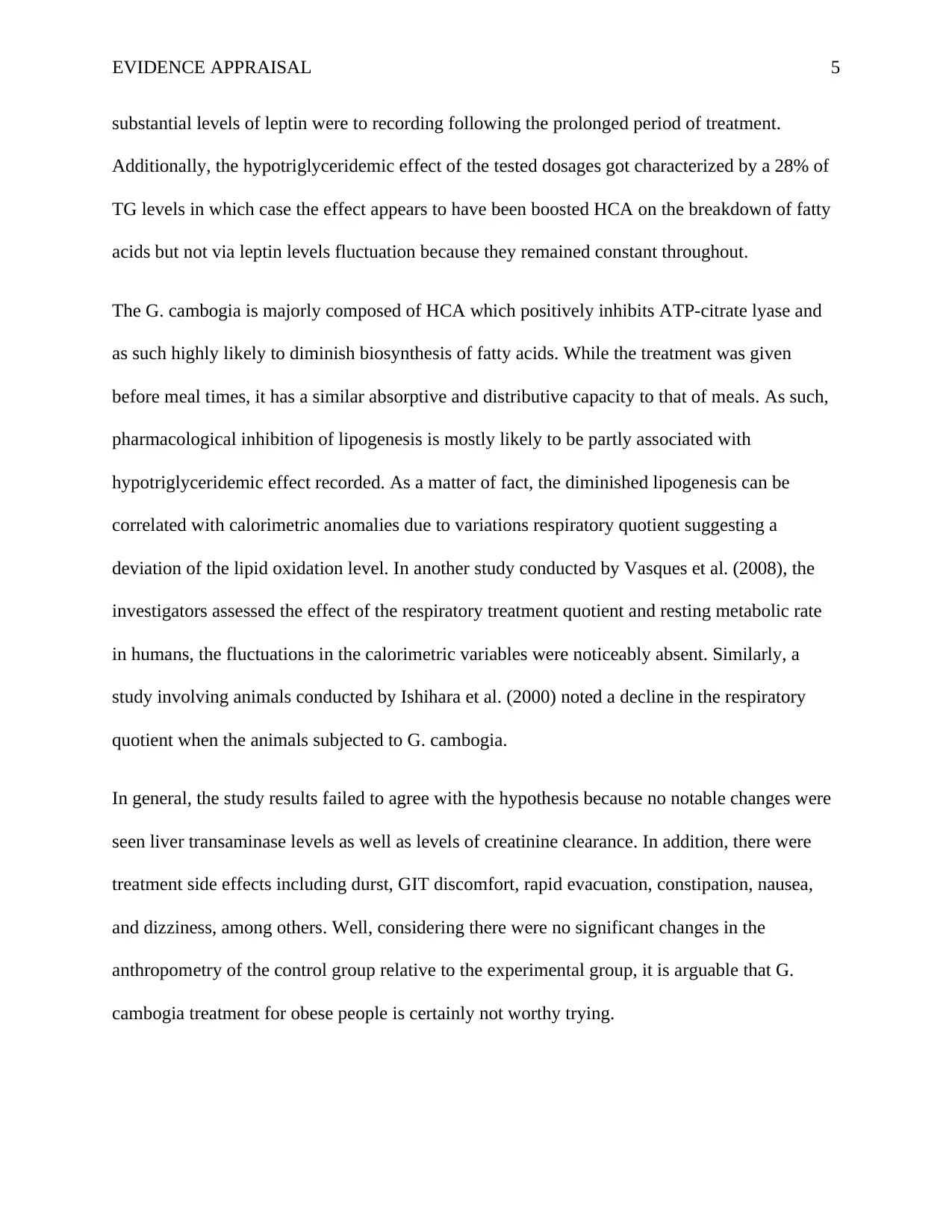
EVIDENCE APPRAISAL 5
substantial levels of leptin were to recording following the prolonged period of treatment.
Additionally, the hypotriglyceridemic effect of the tested dosages got characterized by a 28% of
TG levels in which case the effect appears to have been boosted HCA on the breakdown of fatty
acids but not via leptin levels fluctuation because they remained constant throughout.
The G. cambogia is majorly composed of HCA which positively inhibits ATP-citrate lyase and
as such highly likely to diminish biosynthesis of fatty acids. While the treatment was given
before meal times, it has a similar absorptive and distributive capacity to that of meals. As such,
pharmacological inhibition of lipogenesis is mostly likely to be partly associated with
hypotriglyceridemic effect recorded. As a matter of fact, the diminished lipogenesis can be
correlated with calorimetric anomalies due to variations respiratory quotient suggesting a
deviation of the lipid oxidation level. In another study conducted by Vasques et al. (2008), the
investigators assessed the effect of the respiratory treatment quotient and resting metabolic rate
in humans, the fluctuations in the calorimetric variables were noticeably absent. Similarly, a
study involving animals conducted by Ishihara et al. (2000) noted a decline in the respiratory
quotient when the animals subjected to G. cambogia.
In general, the study results failed to agree with the hypothesis because no notable changes were
seen liver transaminase levels as well as levels of creatinine clearance. In addition, there were
treatment side effects including durst, GIT discomfort, rapid evacuation, constipation, nausea,
and dizziness, among others. Well, considering there were no significant changes in the
anthropometry of the control group relative to the experimental group, it is arguable that G.
cambogia treatment for obese people is certainly not worthy trying.
substantial levels of leptin were to recording following the prolonged period of treatment.
Additionally, the hypotriglyceridemic effect of the tested dosages got characterized by a 28% of
TG levels in which case the effect appears to have been boosted HCA on the breakdown of fatty
acids but not via leptin levels fluctuation because they remained constant throughout.
The G. cambogia is majorly composed of HCA which positively inhibits ATP-citrate lyase and
as such highly likely to diminish biosynthesis of fatty acids. While the treatment was given
before meal times, it has a similar absorptive and distributive capacity to that of meals. As such,
pharmacological inhibition of lipogenesis is mostly likely to be partly associated with
hypotriglyceridemic effect recorded. As a matter of fact, the diminished lipogenesis can be
correlated with calorimetric anomalies due to variations respiratory quotient suggesting a
deviation of the lipid oxidation level. In another study conducted by Vasques et al. (2008), the
investigators assessed the effect of the respiratory treatment quotient and resting metabolic rate
in humans, the fluctuations in the calorimetric variables were noticeably absent. Similarly, a
study involving animals conducted by Ishihara et al. (2000) noted a decline in the respiratory
quotient when the animals subjected to G. cambogia.
In general, the study results failed to agree with the hypothesis because no notable changes were
seen liver transaminase levels as well as levels of creatinine clearance. In addition, there were
treatment side effects including durst, GIT discomfort, rapid evacuation, constipation, nausea,
and dizziness, among others. Well, considering there were no significant changes in the
anthropometry of the control group relative to the experimental group, it is arguable that G.
cambogia treatment for obese people is certainly not worthy trying.
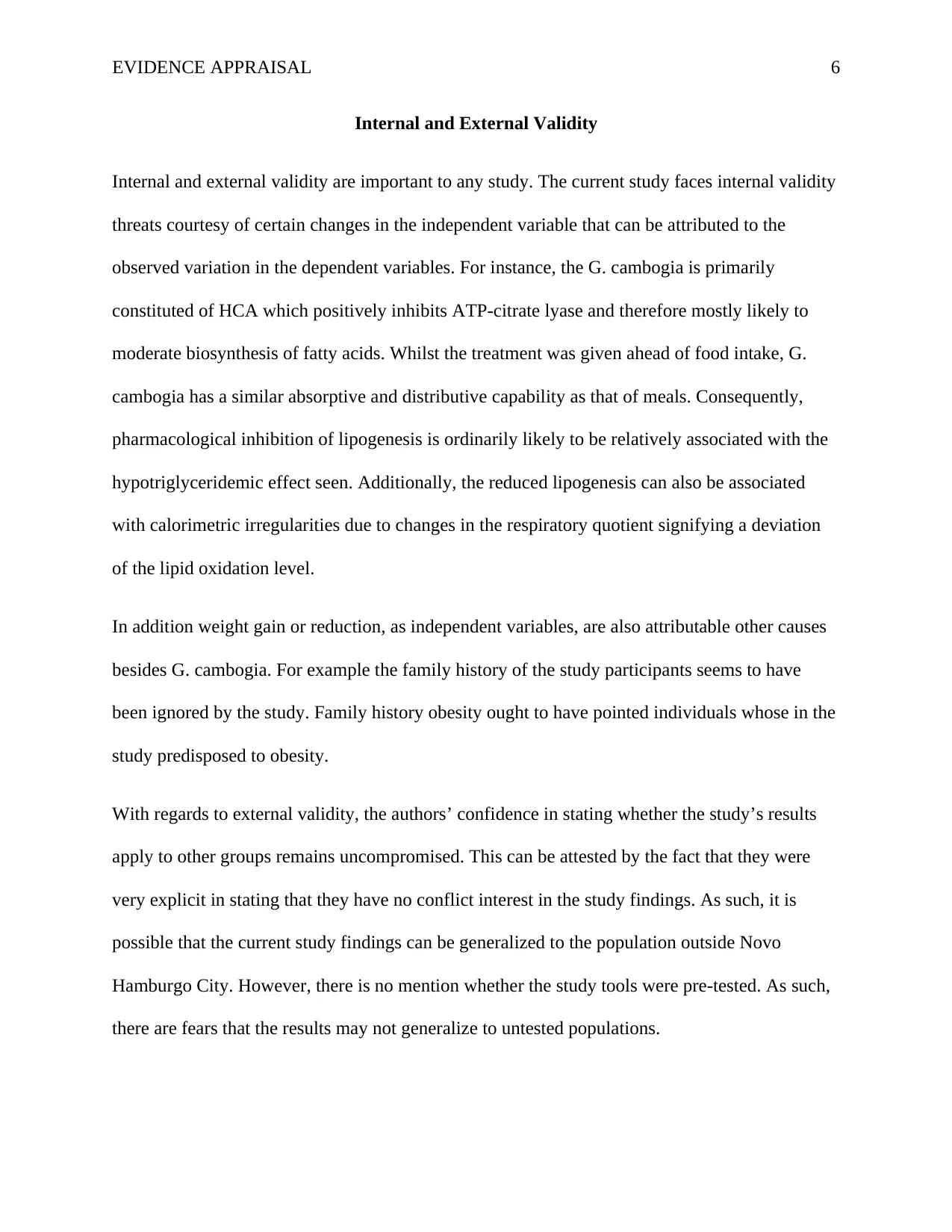
EVIDENCE APPRAISAL 6
Internal and External Validity
Internal and external validity are important to any study. The current study faces internal validity
threats courtesy of certain changes in the independent variable that can be attributed to the
observed variation in the dependent variables. For instance, the G. cambogia is primarily
constituted of HCA which positively inhibits ATP-citrate lyase and therefore mostly likely to
moderate biosynthesis of fatty acids. Whilst the treatment was given ahead of food intake, G.
cambogia has a similar absorptive and distributive capability as that of meals. Consequently,
pharmacological inhibition of lipogenesis is ordinarily likely to be relatively associated with the
hypotriglyceridemic effect seen. Additionally, the reduced lipogenesis can also be associated
with calorimetric irregularities due to changes in the respiratory quotient signifying a deviation
of the lipid oxidation level.
In addition weight gain or reduction, as independent variables, are also attributable other causes
besides G. cambogia. For example the family history of the study participants seems to have
been ignored by the study. Family history obesity ought to have pointed individuals whose in the
study predisposed to obesity.
With regards to external validity, the authors’ confidence in stating whether the study’s results
apply to other groups remains uncompromised. This can be attested by the fact that they were
very explicit in stating that they have no conflict interest in the study findings. As such, it is
possible that the current study findings can be generalized to the population outside Novo
Hamburgo City. However, there is no mention whether the study tools were pre-tested. As such,
there are fears that the results may not generalize to untested populations.
Internal and External Validity
Internal and external validity are important to any study. The current study faces internal validity
threats courtesy of certain changes in the independent variable that can be attributed to the
observed variation in the dependent variables. For instance, the G. cambogia is primarily
constituted of HCA which positively inhibits ATP-citrate lyase and therefore mostly likely to
moderate biosynthesis of fatty acids. Whilst the treatment was given ahead of food intake, G.
cambogia has a similar absorptive and distributive capability as that of meals. Consequently,
pharmacological inhibition of lipogenesis is ordinarily likely to be relatively associated with the
hypotriglyceridemic effect seen. Additionally, the reduced lipogenesis can also be associated
with calorimetric irregularities due to changes in the respiratory quotient signifying a deviation
of the lipid oxidation level.
In addition weight gain or reduction, as independent variables, are also attributable other causes
besides G. cambogia. For example the family history of the study participants seems to have
been ignored by the study. Family history obesity ought to have pointed individuals whose in the
study predisposed to obesity.
With regards to external validity, the authors’ confidence in stating whether the study’s results
apply to other groups remains uncompromised. This can be attested by the fact that they were
very explicit in stating that they have no conflict interest in the study findings. As such, it is
possible that the current study findings can be generalized to the population outside Novo
Hamburgo City. However, there is no mention whether the study tools were pre-tested. As such,
there are fears that the results may not generalize to untested populations.
⊘ This is a preview!⊘
Do you want full access?
Subscribe today to unlock all pages.

Trusted by 1+ million students worldwide
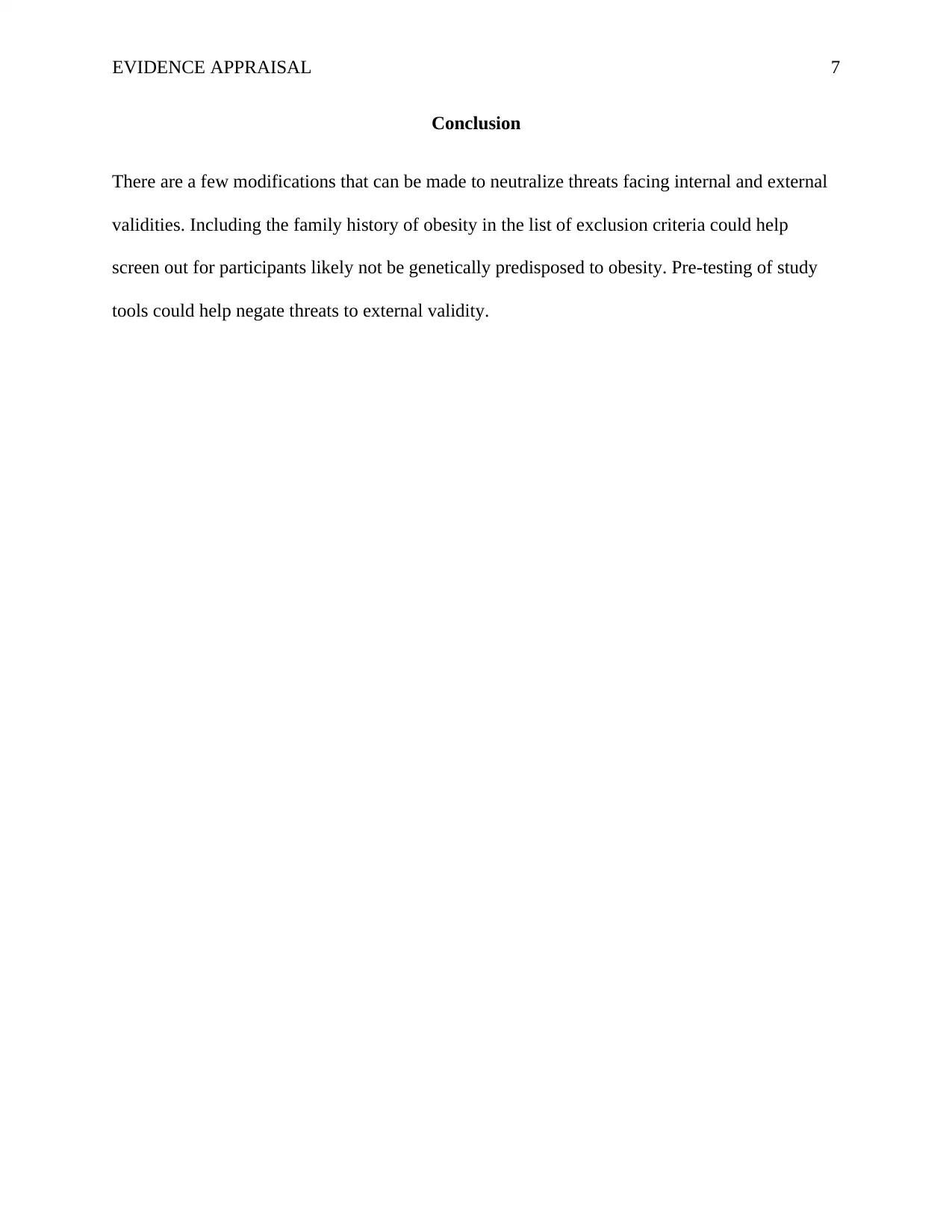
EVIDENCE APPRAISAL 7
Conclusion
There are a few modifications that can be made to neutralize threats facing internal and external
validities. Including the family history of obesity in the list of exclusion criteria could help
screen out for participants likely not be genetically predisposed to obesity. Pre-testing of study
tools could help negate threats to external validity.
Conclusion
There are a few modifications that can be made to neutralize threats facing internal and external
validities. Including the family history of obesity in the list of exclusion criteria could help
screen out for participants likely not be genetically predisposed to obesity. Pre-testing of study
tools could help negate threats to external validity.
Paraphrase This Document
Need a fresh take? Get an instant paraphrase of this document with our AI Paraphraser
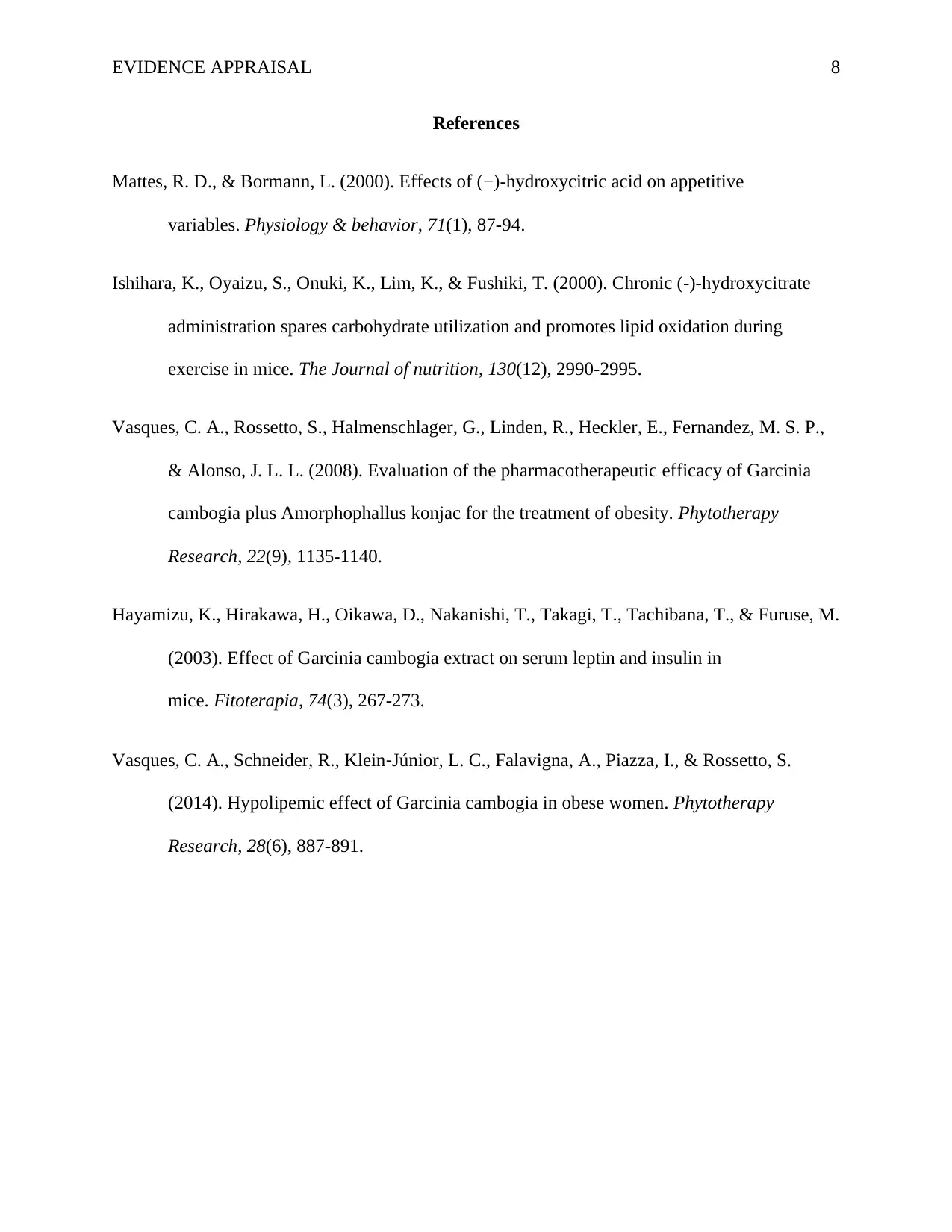
EVIDENCE APPRAISAL 8
References
Mattes, R. D., & Bormann, L. (2000). Effects of (−)-hydroxycitric acid on appetitive
variables. Physiology & behavior, 71(1), 87-94.
Ishihara, K., Oyaizu, S., Onuki, K., Lim, K., & Fushiki, T. (2000). Chronic (-)-hydroxycitrate
administration spares carbohydrate utilization and promotes lipid oxidation during
exercise in mice. The Journal of nutrition, 130(12), 2990-2995.
Vasques, C. A., Rossetto, S., Halmenschlager, G., Linden, R., Heckler, E., Fernandez, M. S. P.,
& Alonso, J. L. L. (2008). Evaluation of the pharmacotherapeutic efficacy of Garcinia
cambogia plus Amorphophallus konjac for the treatment of obesity. Phytotherapy
Research, 22(9), 1135-1140.
Hayamizu, K., Hirakawa, H., Oikawa, D., Nakanishi, T., Takagi, T., Tachibana, T., & Furuse, M.
(2003). Effect of Garcinia cambogia extract on serum leptin and insulin in
mice. Fitoterapia, 74(3), 267-273.
Vasques, C. A., Schneider, R., Klein‐Júnior, L. C., Falavigna, A., Piazza, I., & Rossetto, S.
(2014). Hypolipemic effect of Garcinia cambogia in obese women. Phytotherapy
Research, 28(6), 887-891.
References
Mattes, R. D., & Bormann, L. (2000). Effects of (−)-hydroxycitric acid on appetitive
variables. Physiology & behavior, 71(1), 87-94.
Ishihara, K., Oyaizu, S., Onuki, K., Lim, K., & Fushiki, T. (2000). Chronic (-)-hydroxycitrate
administration spares carbohydrate utilization and promotes lipid oxidation during
exercise in mice. The Journal of nutrition, 130(12), 2990-2995.
Vasques, C. A., Rossetto, S., Halmenschlager, G., Linden, R., Heckler, E., Fernandez, M. S. P.,
& Alonso, J. L. L. (2008). Evaluation of the pharmacotherapeutic efficacy of Garcinia
cambogia plus Amorphophallus konjac for the treatment of obesity. Phytotherapy
Research, 22(9), 1135-1140.
Hayamizu, K., Hirakawa, H., Oikawa, D., Nakanishi, T., Takagi, T., Tachibana, T., & Furuse, M.
(2003). Effect of Garcinia cambogia extract on serum leptin and insulin in
mice. Fitoterapia, 74(3), 267-273.
Vasques, C. A., Schneider, R., Klein‐Júnior, L. C., Falavigna, A., Piazza, I., & Rossetto, S.
(2014). Hypolipemic effect of Garcinia cambogia in obese women. Phytotherapy
Research, 28(6), 887-891.
1 out of 8
Related Documents
Your All-in-One AI-Powered Toolkit for Academic Success.
+13062052269
info@desklib.com
Available 24*7 on WhatsApp / Email
![[object Object]](/_next/static/media/star-bottom.7253800d.svg)
Unlock your academic potential
Copyright © 2020–2025 A2Z Services. All Rights Reserved. Developed and managed by ZUCOL.



